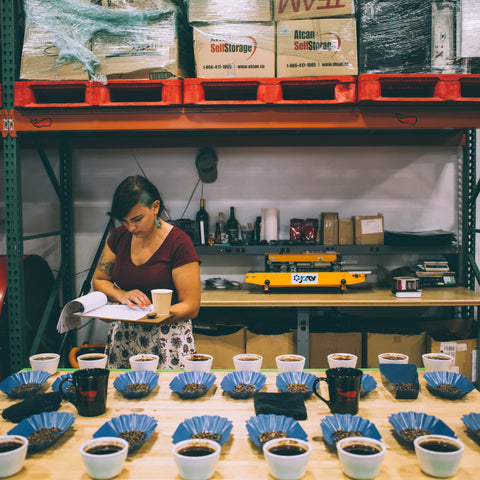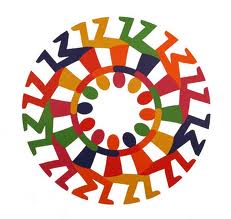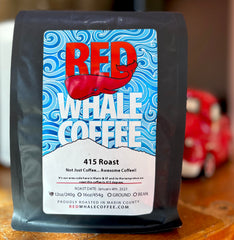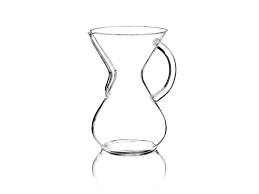Experiencing a Red Whale Cupping

The table is set. Cups arranged in a precise row, trays of sample-roasted beans sit before it, tasting spoons lined neatly along the table, and cupping sheets roosted on each of our clipboards. In the cups, freshly ground coffee from our producer’s sit, awaiting hot water and the start of the cupping.
Coffee cupping is serious business. Everything from the water temperature to grinding the beans fresh to timing each step of the cupping matters. A cupping takes concentration and developing one’s palate to the sophisticated range of flavors each cup offers.
Why is cupping important?

A cupping is a coffee tasting. The cupping allows Q-Graders and other coffee aficionados to grade the coffees and decipher the cupping notes of each coffee. This is also part of the dynamic nature of direct trade coffee, we can communicate with producers after the cupping and discuss what defects were found or where the coffee was exceptional. The producer sends samples of their green coffee beans to the roaster, who roasts and then cups them to pinpoint which beans to buy.

The Different Steps of a Coffee Cupping
Fragrance/ Aroma:

After grinding the coffee, the cupper will take in the aroma of the freshly ground coffee, while surveying the whole beans on the table to note quakers and other defects visible to the eye. The cupper scores the dry coffee and notes which fragrances he picks up.

After judging the dry aroma, the cupper adds hot water to the cup, wetting all grounds and filling it to the brim. After the coffee sits for three to five minutes, the cupper “breaks” the crust, cracking the grounds at the top of the coffee and swirling it with the spoon three times to bring up the aroma.
Tasting:
After notes are gathered on the aroma, it’s on to the next step, tasting the coffee! Coffee is tasted when it has reached the right temperature to sip (a burnt tongue will ruin the tasting experience).
The sip:

Tasting coffee requires that you take a quick sip in. Don’t be afraid to slurp! This quick slurp allows you to pull the coffee into your mouth and taste it across your entire palate.
The first step of evaluating the coffee happens when it has reached around 160 degrees. At these hotter temperatures, one rates the flavor and aftertaste. Next the acidity, body, and balance are rated. As it cools down to room temperature the sweetness, uniformity and cleanliness is evaluated. Then the coffee is added up and scored.

Watch out for defects!
A defect is when something is “off” in the coffee. These negative flavor characteristics can come off as an aroma (or taint) or in the taste (as a fault). These cause the score in intensity to be rated lower (taints are scored at 2, and faults at 4). A defect can have a description like rubbery or sour; those tastes that make you cringe.
The Final Breakdown:

Each of these characteristics helps the cupper break down different aspects of a good cup of coffee. It is then scored and receives a grading 0 and 100. Red Whale Coffee only serves specialty-graded coffee, which means no scores lower than 80 will be served.
Stay tuned for more information on a coffee cupping at Red Whale Coffee! Become part of the coffee process and get the opportunity to learn more about the different characteristics found in coffee.
Blog by Caitlyn Prien
You have your delicious bag of Red Whale Coffee, you can’t wait to brew it up and drink it at home. What are you using to brew it? For the best quality of coffee, considering your brewing equipment and brewing process is important. We have a variety of different brewers available for you to consider. Let’s walk through some frequently asked brewing questions and a few suggestions for home!
How should I store my coffee at home!?
This is a question we are often asked. A common myth is that it is best to store your coffee in a freezer. This is a myth. The freezer destroys the oils in the beans and makes the coffee flat, killing the flavor. The best place to store coffee is in the original Red Whale Coffee bag but if you must transfer your coffee to a container, a sealed glass container, like a Ball Jar or airtight container. Store your beans in a cool place with no sunlight exposure.
Grind: How fine should my grind be?
For the best cup possible, we recommend grinding your coffee immediately before brewing. When the bean is whole, the flavors are sealed inside. After grinding coffee, that flavor is released, meaning that grinding it even hours before you make your coffee will deplete the flavor you enjoy. When a coarser grind is recommended when using a metal filter. When using a paper filter, a finer grind will give you the best result. A coarse grind for coffee allows water to pass through too quickly and if your coffee is ground too fine, the water will have trouble going through the filter, blocking a proper coffee extraction. Stay tuned for more information in February on what sort of grinders we recommend for home use!
Brewing Methods: How much coffee do I use to make my cup?!
We recommend a half-ounce or one tablespoon to each measured cup of water for the proper extraction. Coffee is a very personal experience and there are many varieties of coffee. We can help guide you through the world of coffees to find your perfect coffee fit. Experiment to find your personal preference, brewing methods can either bring out more flavor and oils or less, leaving you with a clarified cup! It’s all a good excuse to drink more coffee!
A question commonly asked: What is the difference between using a paper filter or a metal filter?
A paper filter will give you a cleaner cup; allowing only the liquid to pass through, with no sediment at the bottom of your cup. A grind of 5 is a nice fine grind for a paper filter, you could go a little finer, but be careful! Or the water will not be able to move through the grind.
Extracting coffee with a metal filter creates a deeper cup experience by allowing the fine coffee particulate and oils to pass through the filter, adding depth and a texture to your cup. For the metal Able Kone a coarse grind of about 7 is recommended, but play around to your personal taste.

We offer both paper and metal filters at Red Whale Coffee. The metal, Able Kone filter is made locally in the Bay Area (support local) and is a perfect addition to your home brewing routine. A group of coffee lovers, wanting a sustainable filter option for their Chemex maker, were inspired in the technology and design, to develop a filter that provides the best possible cup.
Brewing Equipment Recommendations
Chemex
If you want a coffee brewer that withstands the test of time, we recommend the Chemex. Invented in 1941, the Chemex is a classic coffee brewer that continues to be one of the best options for coffee brewing. The simplicity of its glass design gives it a modern look, while being functional and heat proof. For the maximum quality of your cup, we recommend pairing it with the Able Kone. The sleek hourglass Chemex shape paired with the Able Kone, is nice look for serving. The coffee can also be stored in the Chemex, sustaining the quality flavor it had when first brewed.
Kone Brewing System

Able Brewing in a effort to build upon the Kone Filter, created the Kone Brewing System. Made from ceramic, it is functional and has a clean simple design, making it ideal for serving to guests or storing the coffee for later use.
AeroPress

The AeroPress Brewer is ideal for travel and making your coffee by the cup. It is economical, easy to clean, and portable. It has a speedy brew time that allows the coffee to have a gentle taste to it, with little room for bitterness. Because the coffee is completely immersed, the extraction is uniform, without a chance of over extraction. It can be used with a paper filter or a metal filter; the AeroPress includes a micro filter to allow rich tastes without the grit and it is made from plastic that is BPA and pthlalates free. A great addition to your vacation getaway or a casual day around the house.
Come down to Red Whale Coffee to check out these brewing systems and our other pour over methods by Melitta and Hario! We are happy to answer any brewing questions that help you get the most out of each cup that you sip at home or in the office!!
Written by: Cailtyn Prien

As 2014 winds to a close, Red Whale Coffee reflects on our growth, opportunities, and friendships that were realized this year. Red Whale Coffee is as much about the people as it is about the coffee; it wouldn’t be Red Whale without all of the wonderful people who contribute to our coffee community!
There are so many, but to thank you all would create a list lasting days, so we will keep it short and name just a few! Thank you all for supporting us and brightening us with your ways!
Special thanks to Steve and Andy who meet here to stay sane and connected during their work days,
Tom, Linda, Chuck, Debra and “Miguel the Mayor”,
Ben, who drives a big white truck,
Cheerful Larry and of course, Craig and all their friends from the County,
Ben, Adam, Angie and Shirley from Kaiser next door,
We can’t forget Mike, Peter and Dr. Matthew Egan,
Marci or Daphne
Great neighbors continue in Warm Things, California Printed of Marin, TLC and Graf!
All of our friends at the YWCA who give us reasons to smile with their every visit,
TRI Studio with Rick’s calm and chill demeanor, including all of the colorful people he brings in with him
Pelo and Star Academy; for all the coffee lovers that work there
Luke with his marketing team and Joe with his never-ending web development support….
Lillian, Sunshine Designs, Sammy Hagar and his guitarist, Vick too!
Where would we be without our coffee producers?
Remembering them for all their hard work in producing quality products, we are especially grateful to Yoddoi Thailand Coffee, Nayarita Coffee, Santa Felisa, and Elida Estate, to name just a few.
We are truly blessed and happy to have all of you as part of the Red Whale Coffee Family! We look forward to and can't wait to see what next year brings! THANK YOU!
Written by: Caitlyn Prien
On the first day of Christmas
My true love sent to me
A Red Whale mug, full of coffee
On the second day of Christmas
My true love sent to me
Two bags of beans,
And a Red Whale mug, full of coffee
On the third day of Christmas
My true love sent to me
Three fresh made pastries,
Two bags of beans,
And a Red Whale mug, full of coffee
On the fourth day of Christmas,
My true love sent to me
Four insulating travel mugs
Three fresh made pastries,
Two bags of beans,
And a Red Whale mug, full of coffee.
On the fifth day of Christmas,
My true love sent to me,
Five glass Chemex,
Four insulating travel mugs,
Three fresh made pastries,
Two bags of beans
And a Red Whale mug, full of coffee.
On the sixth day of Christmas,
My true love sent to me,
Six Baratzas a'grinding
Five glass Chemex
Four insulating travel mugs,
Three fresh made pastries,
Two bags of beans,
And a Red Whale mug, full of coffee.
On the seventh day of Christmas,
My true love sent to me
Seven soft sweatshirts a'warming,
Six Baratzas a'grinding,
Five glass Chemex,
Four insulating travel mugs,
Three fresh made pastries
Two bags of beans,
And a Red Whale mug, full of coffee
On the eighth day of Christmas,
My true love sent to me
Eight Melitta cones a'brewing,
Seven soft sweatshirts a'warming,
Six Baratzas a'grinding,
Five glass Chemex,
Four insulating travel mugs,
Three fresh made pastries,
Two bags of beans,
And a Red Whale mug, full of coffee
On the ninth day of Christmas,
My true love sent to me
Nine latte bowls brimming,
Eight Melitta cones a'brewing,
Seven soft sweatshirts a'warming,
Six Baratzas a'grinding,
Five glass Chemex,
Four insulating travel mugs,
Three fresh made pastries
Two bags of beans,
And a Red Whale mug, full of coffee
On the tenth day of Christmas,
My true love sent to me
Ten Red Whale hats a'capping
Nine latte bowls brimming,
Eight Melitta cones a'brewing,
Seven soft sweatshirts a'warming,
Six Baratzas a'grinding,
Five glass Chemex,
Four insulating travel mugs,
Three fresh made pastries
Two bags of beans,
And a Red Whale mug, full of coffee
On the eleventh day of Christmas,
My true love gave to me
Eleven Aeropress pressing,
Ten Red Whale hats a'capping
Nine latte bowls brimming,
Eight Melitta cones a'brewing,
Seven soft sweatshirts a'warming,
Six Baratzas a'grinding,
Five glass Chemex,
Four insulating travel mugs,
Three fresh made pastries
Two bags of beans,
And a Red Whale mug, full of coffee
On the twelfth day of Christmas,
My true love gave to me,
Twelve Hario drippers dripping,
Eleven Aeropress pressing,
Ten Red Whale hats a'capping
Nine latte bowls brimming,
Eight Melitta cones a'brewing,
Seven soft sweatshirts a'warming,
Six Baratzas a'grinding,
Five glass Chemex,
Four insulating travel mugs,
Three fresh made pastries
Two bags of beans,
And a Red Whale mug, full of coffee
Happy Holidays from all of us at Red Whale Coffee!
Written by: Caitlyn Prien
Red Whale Coffee proudly offers two delicious decaf coffees, a Mexican Swiss Water Decaf and a Sumatra Swiss Water Decaf!

http://spanishdialects-09b.wikispaces.com/file/view/coffee_woman.jpg/105800813/coffee_woman.jpg
How is the naturally occurring caffeine extracted from coffee you wonder? You may even ask yourself why some decaf coffees have no flavor while others are tasty? The answer is in the process method used to extract the caffeine from the bean.
All coffee is decaffeinated using water to wash the caffeine from the bean. The end result taste differences come from the process that also extract the oils and flavor complexity compounds from the bean during decaffeination.

http://www.thrillist.com/drink/nation/how-to-make-decaf-coffee
The Different Methods
The Indirect Solvent Based Decaffeination Process is popularly termed the “European Method” and requires boiling green coffee for hours to extract the caffeine. The beans are soaked in chemicals like methylene chloride or ethyl acetate, which bond to the caffeine for easy extraction. The beans are then heated, burning off the chemically bonded caffeine. The process continues by soaking the bean again in the original liquid to recollect the flavor compounds and oils striped from the bean in the first step of the process.
The Direct-Solvent Based Process is often referred to as the Natural Decaffeination Method or the Ethyl Acetate Method. This process starts by steaming the beans rather than boiling them. The bean pores open and are washed for approximately ten hours with Ethyl Acetate, a compound found naturally in fruit. The caffeine adheres to the Ethyl Acetate and is then separated from the bean. The beans are steamed again as the final step in ridding any residual caffeine bonded to the Ethyl Acetate.
The Carbon Dioxide Method (CO2) is often used for commercial grade coffee because large quantities can be processed at a low cost. In this process, a liquid form of CO2 is mixed with water soaked green beans. Unlike the ethyl acetate or methylene chloride, CO2 only bonds with caffeine, leaving the flavor compounds and oils in the coffee. Once the caffeine has been extracted, the CO2 (now laden with caffeine) is pressurized back to a gaseous state, separating the caffeine from the gas which then allows the CO2 to be reused in repeated decaffeination processes.
The Swiss Water Process, the only decaffeination process sourced by Red Whale Coffee, is the only process that does not use chemicals to extract caffeine from the beans. The Swiss Water Decaffeination Process soaks the bean in near boiling water, extracting the caffeine and while leaving the flavor in the coffee. The caffeinated water is then filtered through a charcoal filter that catches the large caffeine molecules and allows the smaller flavor molecules to remain in the water. This process, referred to as the "Green Coffee Extract", allows the water to retain its natural flavors without the caffeine. The final process of returning the flavor to the bean, which is used in all other decaffeination methods, is not needed in this method. The Swiss Water Process is also, the only process recognized as environmentally friendly, sustainable and approved for organic coffee beans.
Familiarizing yourself with the different processes for decaffeination is helpful when choosing your beans. The different processes have varying successes in keeping the robust flavor of the coffee bean without the naturally occurring caffeine.
We invite you to come see us at Red Whale Coffee to try our new Sumatra Swiss Water Decaf! Now that you know the process you can taste the result!
Written by: Caitlyn Prien



















